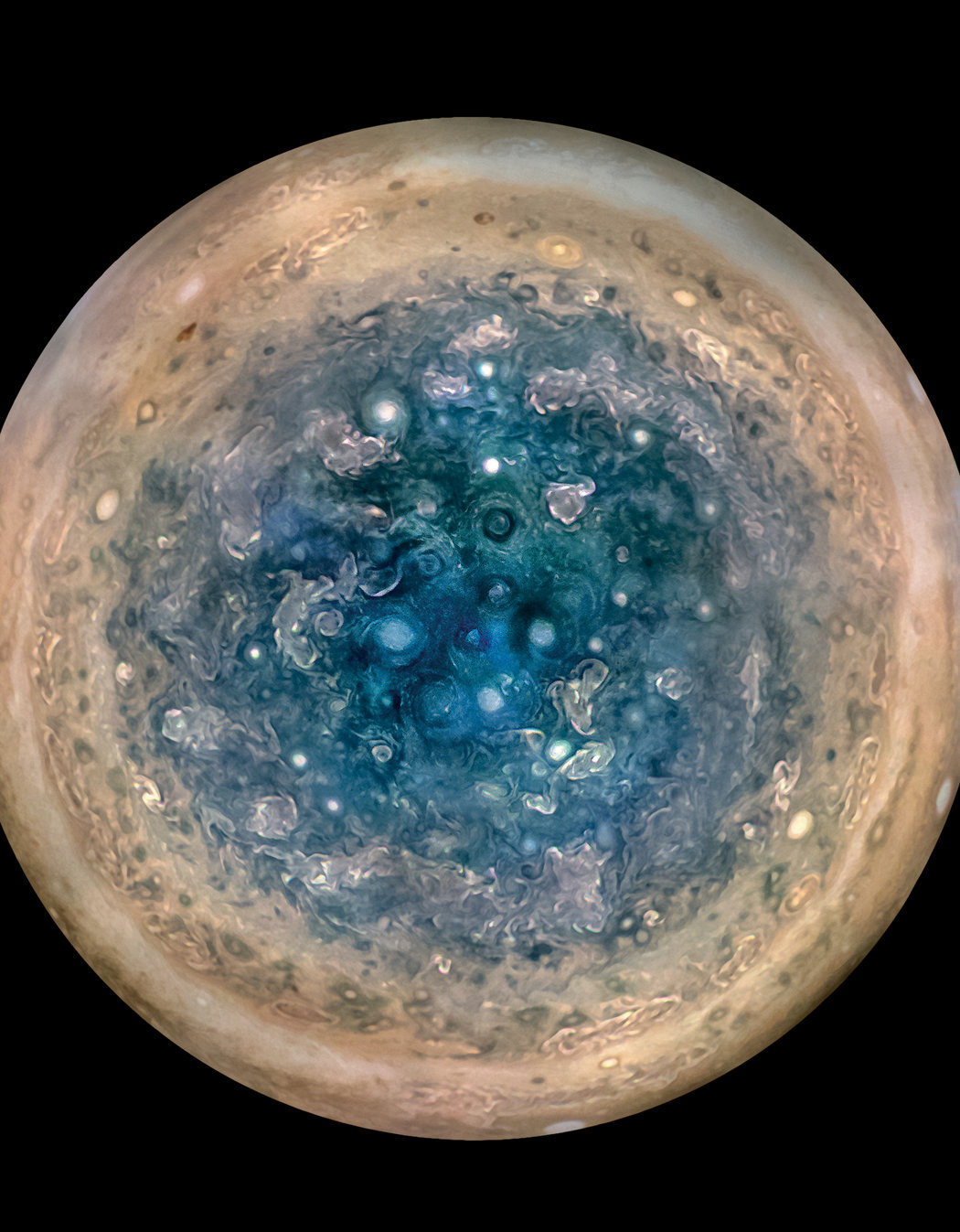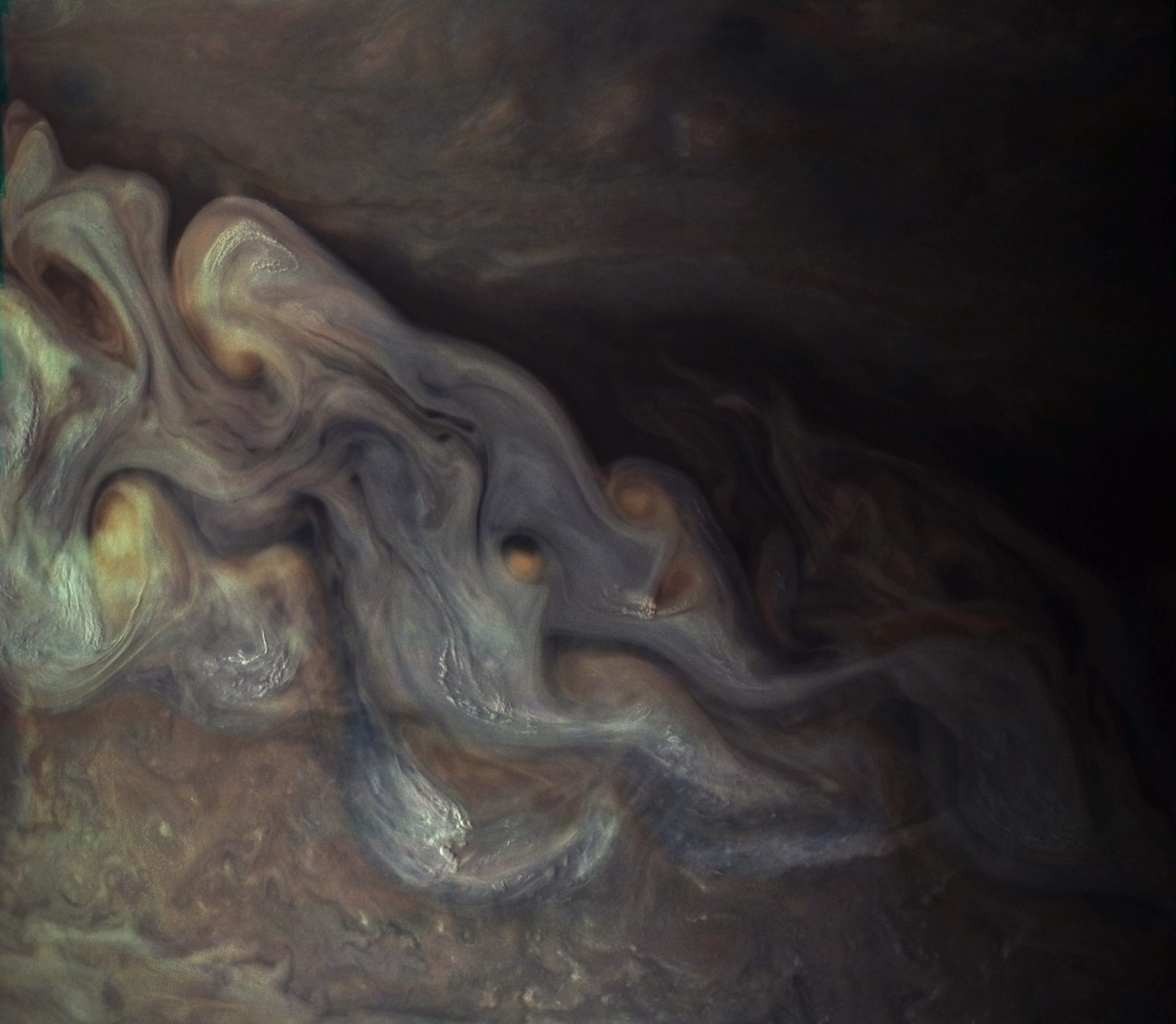
Those are some early findings of scientists working on NASA's Juno mission, an orbiter that arrived at Jupiter last July.
Juno takes 53 days to loop around Jupiter in a highly elliptical orbit, but most of the data gathering occurs in two-hour bursts when it accelerates to 129,000 miles an hour and dives to within about 2,600 miles of the cloud tops. The spacecraft's instruments peer far beneath, giving glimpses of the inside of the planet, the solar system's largest.
"We're seeing a lot of our ideas were incorrect and maybe naïve," Scott J. Bolton, the principal investigator of the Juno mission, said during a NASA news conference on Thursday.
Two papers, one describing the polar storms, the other examining the magnetic fields and auroras, appear in this week's issue of the journal Science. A cornucopia of 44 additional papers are being published in the journal Geophysical Research Letters. The papers describe findings based largely on the first two close passes of Jupiter in which Juno was able to make measurements. Juno has now made five, with the next on July 11, when it is to pass directly over the Great Red Spot.
Scientists are puzzled to see that the familiar striped cloud patterns of Jupiter may be only skin deep. An instrument collecting microwave emissions probes the top layers of the atmosphere, but that data does not reflect what is seen in the clouds. "These zones and belts either don't exist or this instrument isn't sensitive to it for some reason," Dr. Bolton said.
The microwave instrument did detect a band of ammonia rising in the equatorial region from at least a couple of hundred miles down — "the most startling feature that was brand-new and unexpected," Dr. Bolton said.
In measuring the gravitational field, scientists hoped to learn what lies at the center of Jupiter. Some predicted a rocky core, perhaps the size of Earth or several Earths. Others expected no rocky core, but hydrogen, the planet's main constituent, all the way down. "Most scientists were in one camp or the other," Dr. Bolton said, "and what we found is neither is true." Instead, the data suggests a "fuzzy core," one that is larger than expected, but without a sharp boundary, perhaps partly dissolved.

John E.P. Connerney, a scientist at NASA's Goddard Space Flight Center in Greenbelt, Md., and the deputy principal investigator on the mission, reported spatial variations in the magnetic field that were much stronger than expected in some areas and much weaker in others.
The magnetic field is generated by the churning of electrically charged fluids at the core. On Earth, that comes from the convection of molten iron in the outer core. On Jupiter, the currents come from hydrogen, which turns into a metallic fluid under crushing pressures.
The spatial variations suggest that the dynamo of churning currents is larger than had been thought and may extend beyond the metallic hydrogen region, Dr. Connerney said.
For the magnetic field and gravity measurements, a glitch that has greatly slowed the pace of data gathering could turn out to be beneficial. A final engine burn last October was to put Juno in a 14-day orbit, but a pair of sluggish valves in the fuel system led mission managers to forgo that, and Juno remains in the 53-day orbit instead. The spacecraft is to make the same number of orbits and collect the same amount of data, and the longer mission means that Juno may be able to detect slow changes in the magnetic field.
More surprises were found at the top and bottom of Jupiter.
With Juno's orbits passing almost directly over the north and south poles, scientists can better study the powerful auroras, which are generated by charged particles traveling along Jupiter's magnetic field and colliding with molecules in the atmosphere. In Earth's case, charged particles from the sun speeding outward through the solar system are diverted by the planet's magnetic field toward the poles, generating light when they collide with air molecules. The expectation was that the same would occur at Jupiter, and it does to some extent.
But Juno also detected charged particles — mostly electrons — traveling in the opposite direction at Jupiter: out of the planet into space. "It's a 180-degree turnabout from the way we were thinking about those emissions," Dr. Connerney said.
He said a voltage differential in the atmosphere was drawing the electrons upward.
Earlier photographs of the polar regions were taken from a sharp angle, with details hard to make out. Juno revealed that the clouds there are very different from the usual Jupiter stripes. "What you see is incredibly complex features, the cyclones and anticyclones all over the poles," Dr. Bolton said.
Planetary scientists had wondered whether Jupiter would have a giant hexagonal pattern like that spotted on Saturn by NASA's Cassini spacecraft.
On Wednesday, NASA released new images of Saturn's north polar region, which has changed color in the last four years, possibly because summer has reached the northern hemisphere.
In the final stages of Cassini's mission, which ends in September, it has shifted to a looping elliptical orbit, which will enable similar probing of Saturn's interior.
"Eventually we will compare," Dr. Bolton said. "We will really be able to advance our understanding of how these giant planets work."



Science is never wrong!